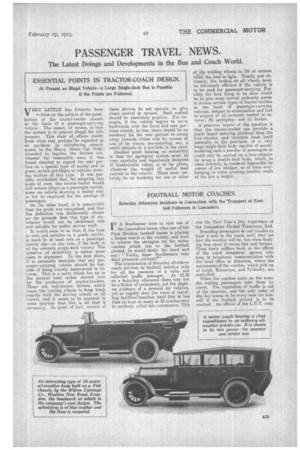PASSENGER TRAVEL NEWS.
Page 19

If you've noticed an error in this article please click here to report it so we can fix it.
The Latest Doings and Developments in the Bus and Coach World.
ESSENTIAL POINTS IN TRACTOR-COACH DESIGN.
At Present an Illegal Vehicle—a Large Single-deck Bus is Possible it the Points are Followed.
VERY LITPLE has hitherto been written on the subject of the possibilities of the tractor-trailer chassis as the basis of a passenger-carrying vehicle. The reason, of course, is that the system is at present illegal for this purpose. This state of affairs results from what may perhaps be regarded as an accident. In introducing amendments to the Heavy Motor Car Ordee intended to legalize the flexible sixwheeler for reasonable uses, it was found simplest to regard the rear portion ae a special type of trailer and to grant certain privileges to vehicles drawing trailers of this type. It was possibly overlooked that, by adopting this point, of view, the tractor-trailer would still remain illegal as a passenger carrier, since no vehicle drawing a trailer may in law be employed for the carriage of passengers.
On the other hand, it, is conceivable that the point was recognized, and that the definition was deliberately chosen on the grounds that this type of sixwheeler would not be absolutely safe and suitable for public service work.
It would seem to us that, if the type is safe and suitable as a goods carrier, it must, be at least safe as a passenger carrier also—at any rate, if the body is of the ordinary single-deck variety. The qeestion of suitability is rather more open to argument. In the first place, it is eminently desirable that any passenger-carrying vehicle should be capable of tieing exactly imareeuvred in reverse. This is a point which has up to the present been rather slurred over by the producers of tractor-trailers. There are well-known devices which cause the trailing wheels to keep track exactly with the driving wheels on all curves, and it seems to be assumed in some quarters that this is all that is necessary. In point of fact, certain or these devices do not operate to give eIsiet control in reverse. Such control should -he absolutely positive. For example, if the vehicle begins to move backwards with the front and rear portions exactly in line, there should be no tendency for the rear portion to swing away towards either side by reason of one of its wheels encountering, say, a small obstacle or a pot-hole in the road. Another" point bearing on suitability is that the springing system must be very carefully and ingeniously designed if comfortable riding is to be given, whatever the weight of useful load carried in the vehicle. There must certainly be no tendency for one or other
of the trailing wheels to lift at corners write–the load is light. Finally and obviously, the brakes, on all v.-heels must be extremely efficient ii the vehicle is to be used for passenger-carrying. Possibly the best thing to be done would be to give some central authority power to license certain types of tractor-trailers as the ba.si_s of passenger-carrying vehicles, subject to examination and test in respect of (a) accurate control in reverse; (6) springing: and (c) brakes.
A preemie aspect or the question is that the tractor-trailer can provide a much larger carrying platform than the four-whooler, and therefore lends, itself naturally to the provision of a very large single-deck body capable of accommodating such a number of passengers as could only he carried on a. four-wheeler by using a double-deck body, which, in some districts, is rendered impossible by reason of low bridges, or of" trees overhanging or wires crossing country roads at too low a height.




























